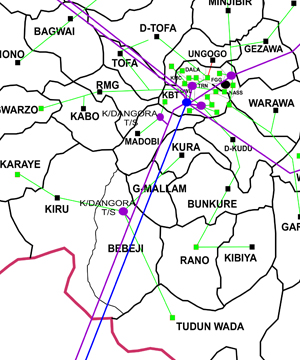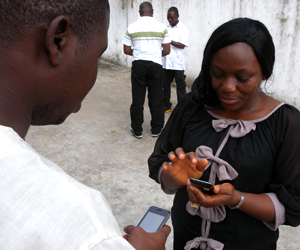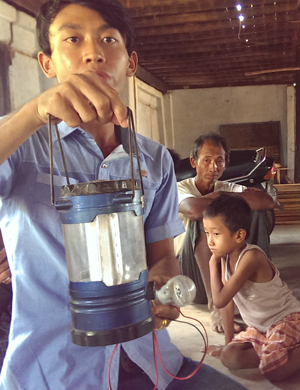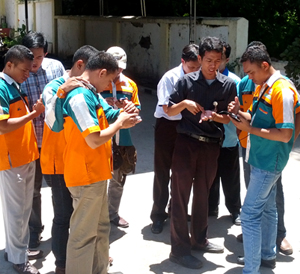More than 800 million people worldwide, many of whom live in sub-Saharan Africa, do not have access to electricity. Achieving access to it is critical for expanding economic opportunity, ensuring food security and reaching other key measures of human development. Research and investments tend to focus on improving energy access in homes, schools and health facilities, with less emphasis on providing energy access for income-generating activities, such as farming and small businesses. Through partnership and innovative data collection and analysis, the project aims to unlock economic opportunities across sub-Saharan Africa and beyond.
Most rural communities have two options for electrification: wait for the electricity grid, or installing their own home-based systems with high up-front costs. SharedSolar introduces a third: community-based solar grids with smart metering, and mobile phone-based pre-paid credit that allow electricity purchase in small increments.
Irrigation of crops is critical to agricultural success, but in Senegal, this task is usually done by hand and can take all day. High fuel costs make gasoline pumps unaffordable and initial investment costs of stand-alone solar are too high for small scale farmers. The Sustainable Engineering Lab, as part of Powering Agriculture: An Energy Grand Challenge for Development Initiative, is piloting research in the Millennium Village of Potou, to reduce the price of energy for farmers by introducing solar PV as a reliable and cost-effective alternative. The grant is supported by the U.S. Agency for International Development (USAID) the Swedish Government, Duke Energy, and the German Organization for International Cooperation (GIZ).

Despite abundant domestic energy resources, only around 20 percent of Nigerians have grid electricity, millions rely on electricity from generators, and about 80 million people lack electricity access altogether. In recent years, the country has embarked on an ambitious effort to reform the electricity sector. With funding from the World Bank, utilities seek planning assistance for both rapid expansion of grid networks as well as approaches to increase off-grid access. As a result, SEL began working closely with the domestic utility—KEDCO, which serves Kano, Jigawa, and Katsina states—to create geo-spatially referenced maps of existing electricity infrastructure and subsequently plan for greater access. The work with KEDCO is intended as a pilot, to investigate local datasets and best practices for SEL’s data-driven approach to be expanded to national scale.
The Sustainable Engineering Lab is investigating disparities in electricity access and consumption in the capital of India. High resolution electricity load data at the 11-kV feeder level was collected for 2010 – 2013 from all five electricity distributions companies serving Delhi — including three private utilities, the New Delhi Municipal Corporation (NDMC) and the Military Engineer Services (MES). Clusters of feeders comprising sub-grids were geo-coded and Voronoi polygons were created to approximate the area being serviced by each. These “grid areas” (dashed lines) have been overlaid on an administrative map of Delhi and its 9 districts. We are currently looking for population, income, and other socio-economic/demographic data at the district/sub-district level that can then be associated with the weekly electricity consumption data recorded for each grid.

Liberia has one of the lowest electrification rates in the world. The country’s Ministry of Lands, Mines and Energy (MLME), power company (LEC), and Rural and Renewable Energy Agency (RREA), have a mandate to increase electricity access nationally. The Sustainable Engineering Lab worked with them to develop a master plan for investment in both on and off-grid electricity systems using GIS-mapping and analysis tools.
The Modi Research Group's New York City Energy Mapping Project was jointly presented by Professor Vijay Modi and PhD student, Bianca Howard at the NorthEast Clean Heat and Power Initiative conference. The interactive map represents the total annual building energy consumption at the block level and at the taxlot level for New York City, and is expressed in kilowatt hours (kWh) per square meter of land area. The estimate for New York City-specific building energy use was based on a statistical model that utilizes zipcode-level energy consumption data to estimate the average annual energy use for every tax lot — at practically building level — through all five boroughs of the city.

Amidst the many political and economic changes underway in Myanmar, an important focus of the national development agenda is increased electricity access nationwide. Currently, about 30 percent of the population is connected to the grid, and much of this is concentrated in large urban centers like Yangon and Mandalay, while most rural areas lack access. With support from the World Bank, the Sustainable Engineering Lab is helping to fill a knowledge gap of where and how the utilities, donors, and the private sector can prioritize investments in a combination of grid and off-grid technologies, to address the needs of the country as a whole. SEL is providing methods, tools and trainings in a comprehensive geo-spatial planning approach that uses multiple local data sources, combined with algorithmic processes, to produce a Least-Cost Geospatial Electrification Plan for universal access throughout Myanmar by 2030.
Natural gas is a growing share in the global primary energy mix—currently representing 21%—and quickly gaining importance in the developing world. While this resource is already being exploited at relatively large scale in some sub-Saharan countries, the majority is exported outside of the continent with limited domestic use. In recent years, huge offshore natural gas resources have been identified in East Africa (Mozambique and Tanzania). This represents a significant primary energy resource and offers the possibility to support both economic growth and much needed energy access in the region. Natural gas can potentially play an important role in the energy mix for various uses like cooking, power generation, transport and fertilizer manufacture.
Energy issues facing society are one of the biggest technological and policy challenges of the twenty-first century. The Sustainable Engineering Lab is working with the ECOWAS Centre for Renewable Energy and Energy Efficiency (ECREEE), the United Nations Industrial Development Organization (UNIDO), and the Engineering Department of the University of Cape Verde in Mindelo, Sao Vicente, to design an innovative distance-learning program intended to build skills of experts in the field of sustainable energy systems and solutions, beginning with a pilot group of 9 West African students.

While Indonesia is rapidly moving toward electrification nationwide, underserved populations still exist, particularly in rural and remote areas on the country’s smaller, Eastern islands. SEL worked with the national electric utility (PLN) along with compiling domestic geospatial data sources to map high-need populations and developed a least cost electrification plan including on and off-grid electrification options.
The portable PowerPack has multiple potential uses but was primarily designed to address the lighting needs of rural populations in developing countries where nearly two billion people worldwide currently lack access to electric lighting.
Access to safe drinking water is an immense and multi-faceted problem in the developing world. Quench is a smart water dispensing solution that ensures all-day access to safe drinking water and allows accurate metering and monitoring of water supply and usage, including the provision of a daily “lifeline” amount of water to all households using the system.
Can mHealth revolutionize mother and child care in India? The Sustainable Engineering Lab is creating a custom app for Android tablets with research partners World Health Organization and Foundation for Research in Health Systems, and technology partner Thoughtworks. The Dristhi app aims to improve the quality of care provided by Auxiliary Nurse-Midwives in rural India.
The Earth Institute’s Millennium Villages project (MVP) is striving to help nearly 400,000 people across 10 African countries to meet the MDGs by 2015. It is widely recognized that infrastructure is an essential building block for countries to meet their larger development goals. The Sustainable Engineering Lab has been influential in shaping the MVP’s evolution through a set of innovative water and energy solutions.
Nigeria’s Office of the Senior Special Assistant to the Millennium Development Goals (OSSAP-MDGs) has constructed an ambitious programme to provide conditional grants to hundreds of Local Government Areas in Nigeria through a data-driven process. The Sustainable Engineering Lab designs and builds tools, as well as works directly with OSSAP-MDGs to use these tools to implement the process of data-driven planning at scale. Formhub and NMIS are key anchor tools for this project and prompted the development of Revisit.

Changing farming practices based on soil chemistry can dramatically increase productivity. The Soil Doctor project circumvents logistical barriers to adoption (shipping and tracking of soil samples from field to lab, and of results back) by providing a “lab in the box” that visits the farmer. The Sustainable Engineering Lab provides a cell phone app that pairs with the lab to collect information, provide recommendations, and track uptake and impact over time.